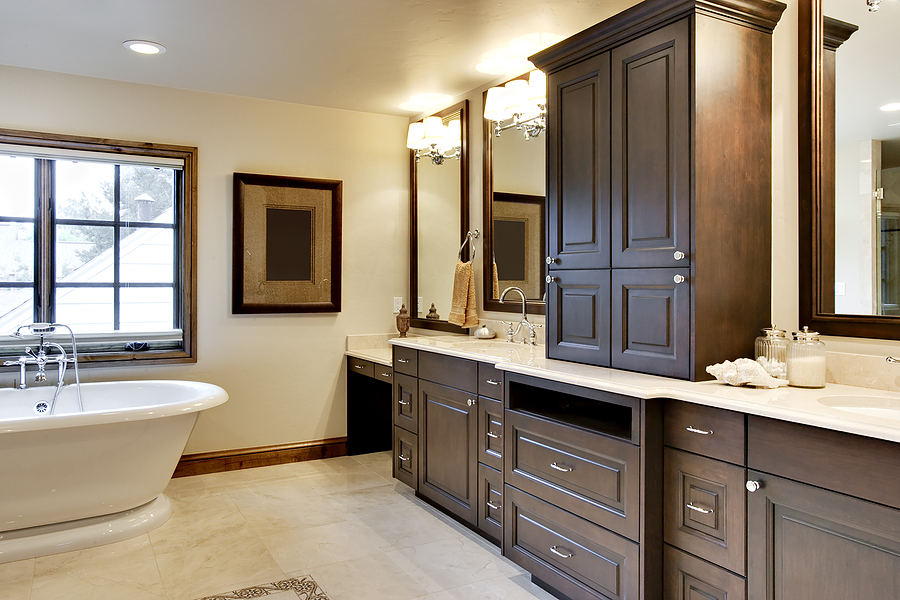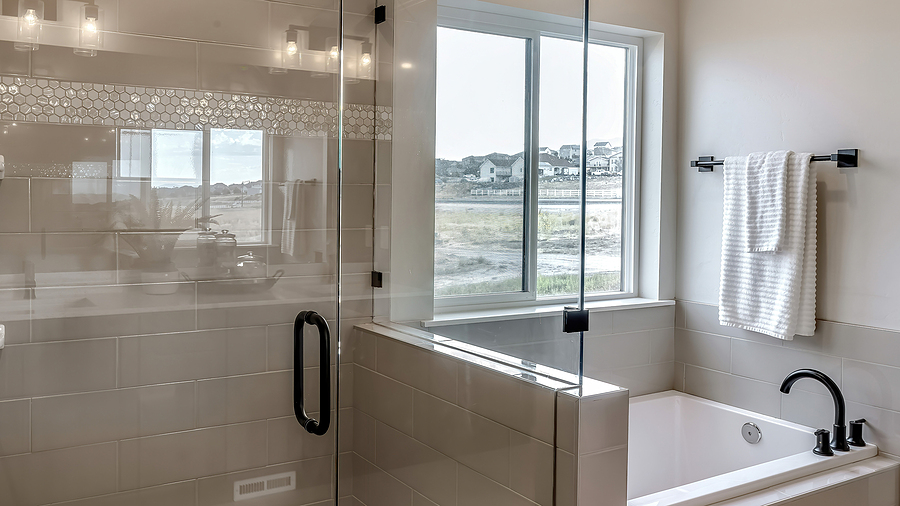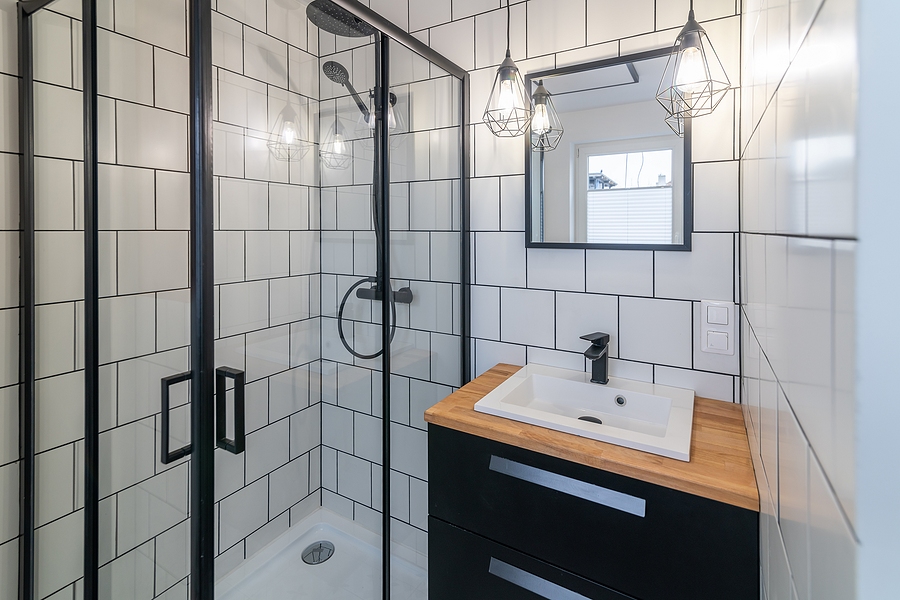
How Much Does it Cost to Remodel a Small Bathroom?
Are you thinking about remodeling your small bathroom but want to know more about the price tag? Here’s what you should know about the cost of a remodel.
Small Bathroom Remodeling Guide
Did you know that the size of an average bathroom in the United States is around 40 square feet? If you have a particularly small bathroom, you might be wondering how much it might cost to remodel it. Unfortunately, there is not one single answer to this question as the answer depends on a variety of factors.
For example, do you plan on remodeling the entire bathroom or only part of it? What kind of features do you plan on replacing? How do you want the resulting bathroom to look after the bathroom remodel?
All of these factors will affect the total cost of the bathroom. If you want to stay within your budget, it is important to consider the many factors that go into small bathroom remodeling. Keep reading and learn more about what you should consider below and how the pricing comes into play.
Does Remodeling a Bathroom Increase the Value of My Home?
The first thing you should know is that the average cost of a bathroom remodel is between $1,500 and $15,000. This, of course, is a very large range. The total cost will mainly depend on how much of your bathroom you plan to remodel and what kind of materials you plan to use. Here is a chart showing average cost vs potential added home value.
| Small Bathroom Size | *Estimated Cost | **Potential Increase in Home Value |
|---|---|---|
| 3×5 | $1,900 – $5,000 | $2,700 – $9,200 |
| 4×6 | $2,200 – $4,700 | $2,700 – $9,200 |
| 4×8 | $3,800 – $9,300 | $3,900 – $16,800 |
| 5×7 | $4,500 – $9,999 | $5,200 – $17,500 |
| 5×8 | $5,400 – $11,500 | $6,900 – $19,800 |
| 5×9 | $5,900 – $12,800 | $6,900 – $21,300 |
| 5×10 | $6,250 – $14,900 | $7,200 – $23,500 |
| 6×6 | $5,800 – $11,400 | $6,400 – $18,300 |
Remodeling a bathroom, in general, can be an expensive project. For that reason, it only makes sense that you should try to get some of your money back from it if you ever plan to sell your house in the future. In some cases, you can indeed increase the value of your home by remodeling your bathroom.

However, this won’t occur in all cases. Again, it all depends on how you remodel your bathroom. For example, suppose you get a brand new sink and shower for your bathroom.
New appliances are always helpful when trying to increase the value of your home. They will also make it easier to sell your home. When potential homebuyers see that your house has a new sink and shower, they can rest easy knowing that they won’t have to replace them themselves or worry about repairs for many years.
Bathroom Materials
Certain bathroom design features may also increase the price of your home. This usually applies to more expensive materials such as the following:
- Marble
- Porcelain
- Limestone
- Travertine
These materials have inherent value and it only makes sense that this value will translate into the price of your house. Of course, these materials on their own will also cost quite a lot. If you don’t have the funds to invest in these materials for your bathroom, you shouldn’t buy them for the sole aim of increasing your house price.
You should, however, avoid materials that may keep your home price the same or even lower it. For example, materials that require a lot of maintenance tend to be unattractive to potential homebuyers and will not do much to improve the price of your house. You should also avoid odd colors for the walls as they will not help either.
What Is the Cheapest Way to Remodel a Small Bathroom?
As mentioned before, remodeling a bathroom, even a small one, can be quite an expensive venture. If you’re not careful, you could easily end up going over your budget and spending more than you wanted to. At that point, you might end up regretting ever remodeling your bathroom in the first place. There are a few simple ways to help you get a cheaper bathroom remodel cost, such as:
- Do not relocate plumbing
- Consider recycled materials
- Do it yourself
- Use subway tile
- Choose paint instead of tile
Fortunately, there are a few ways in which you can remodel your bathroom without having to spend an arm and a leg. First of all, you will want to consider how much of your bathroom you really want to remodel. Of course, remodeling the entire bathroom will cost you a lot more than remodeling only part of it.

Suppose that the majority of your bathroom is still in good shape and not all that old. Even the shower and sink are in good working order and don’t need to be replaced. However, you want to give the bathroom a new and modern look.
In this case, you would only need to pick out some paint for the walls and ceiling along with some new flooring options. You might also decide to get new countertops and cabinets. If you are mainly focusing on the decor part of the bathroom renovation, then you will find that you won’t actually need to spend that much.
That way, you can enjoy all the benefits of a renovated bathroom without having to empty your wallet. The opposite might also be true. Your bathroom design might already be great but you want to replace the shower, sink, and toilet.
What You Need to Know
Since you won’t be spending money on any decor, you again won’t have to spend all that much money since you will mainly be focusing on a few parts of the bathroom. In general, if you only remodel half of the bathroom at one time, you won’t have to spend all that much. But what about if you want to remodel the entire bathroom without going over your budget?
In this case, you will need to stick with cheaper options such as:
- Vinyl floors
- Linoleum
- Ceramic
- Concrete tiles
You will also want to stick with the more affordable versions of showers, toilets, sinks, and so on. However, just because you opt for the cheaper versions doesn’t mean that the resulting remodel can’t look good. As long as you put some thought into this project, the result should still look great.
If you can’t decide on the materials you want to use, it is a good idea to look at bathroom remodel pictures online or in magazines. That way, you can get a better idea of how different materials look for the floors, walls, and so on. You can also better visualize how different color schemes go together.
Once you do that, it will be much easier to choose the right colors and materials for your own bathroom remodel.
How Much Does It Cost To Install a Shower in a Small Bathroom?
Expect to pay somewhere between $1900 and $15,000 to remodel a small bathroom. The total cost of installing a shower in your small bathroom will depend on a variety of factors.
For one, do you plan to hire professional installers to do the job for you or do you plan to do it yourself? Many people try to install things on their own even if they don’t have any experience. The cost to install shower varies based on the type of shower you choose, such as:
- Prefabricated showers
- Glass enclosure showers
- Custom shower designs
- Corner enclosure showers
- Shower-tub combination
This is because, if you do decide to install a shower on your own, you will save yourself some money. However, it might not be a good idea if you’ve never installed a shower before. Keep in mind that you will have to have the strength to haul the shower into the bathroom and then shift it into place.

You will also need to figure out how to hook up the shower to the water system. You will then need to seal the shower in the room so that water doesn’t get behind the shower and the wall. If this happens, water damage could start to take hold and you might be dealing with mold and water damage problems down the line.
If you have installed showers before, then there is nothing stopping you from installing your own. This, as mentioned before, will save you some money since you won’t need to pay laborers by the hour or by the project. However, if you don’t know much about installing showers, it is a good idea to hire some professionals anyway even if it will cost you extra.
Shower Costs
Hiring people to install the shower usually isn’t that expensive and you usually won’t need to pay more than a few hundred dollars for the labor alone. However, you will also need to keep the cost of the shower in mind. There are all different types of showers to choose from and some are much more expensive than others.
If you only want a very basic and small shower made of cheap materials, you likely won’t need to spend much more than a thousand dollars. On the other hand, if you want a large, luxurious shower made out of porcelain or other expensive materials, you will obviously need to pay quite a lot more. There are also certain showers that have all sorts of advanced features such as water jets, water massagers, and so on.

The more features your shower has, the more expensive it will be. If you want your shower to look nice and to have all the amenities you could possibly ask for, then you shouldn’t be too surprised if you have to spend several thousand dollars on it. On the other hand, if you are on a tight budget, you’ll have to stick with some of the more basic shower options.
This is not necessarily a bad thing. As long as a shower works the way it’s supposed to, it’s still a good shower.
How Much Does It Cost To Install a Walk-in Shower in a Small Bathroom?
Walk-in showers can cost as little as $2200 or as much as $7,000+. Speaking of shower costs, you will also need to think about how the cost of a walk-in shower differs from the cost of a regular shower. Keep in mind that not all walk-in showers are made the same. Some, as with regular showers, are much more expensive than others.
It mainly depends on the size of the shower and the materials used. You will also need to add in the cost of installation. The price to install a walk-in shower is not usually all that much different than the cost to install a regular shower.
However, if the walk-in shower is particularly large or complicated, you might have to pay more for labor. This is because the project may require more workers at one time and it may also require the workers to work for a longer period of time. Some walk-in showers are around ten thousand dollars while others can go for twenty thousand, if not more.
Walk-in Shower Variations
Larger walk-in showers often come with glass panels and are very stylish. Smaller and cheaper walk-in showers, on the other hand, are still functional but may not have the style you’re looking for. The price of this project will also depend on the number of shower heads the shower has.
The more shower heads a walk-in shower has, the more expensive it will be and the more complicated it will be to install. The design of the shower itself may also play a part. You will notice that the sleeker and more attractive walk-in showers are often far more expensive compared to the showers that are more basic.
For that reason, if you want your walk-in shower to really look good, you should expect to pay more money. Whatever the case, you will need to balance what you want out of your shower with what kind of budget you have available.
How Much Does It Cost To Install a New Tub in a Small Bathroom?
The cost to install a new bathtub in a small bathroom will be between $2,000 – $7,000. In general, tubs are quite a lot cheaper to install compared to showers. This is because most people prefer showers due to their convenience. However, this does not mean that a bathtub is a bad choice for your bathroom renovation. There are four basic styles of bathtubs, which are:
- Standard bathtubs
- Freestanding tubs
- Walk-in bathtubs
- Soaking tubs
In fact, there are some very nice and luxurious bathtubs that you can choose from. There are also some basic choices that will cost you well under a thousand dollars. This, of course, is ideal if you are on a tight budget.
If you want a more luxurious type of bathtub, you can end up spending a few thousand dollars and as much as ten thousand dollars. This, however, is still much cheaper compared to the cost of a high-qualty walk-in shower. Installing a bathtub also tends to be simpler than installing a shower, so you won’t need to spend too much on hired labor either. Some common materials used for luxury bathtubs include:
- Cast iron bathtubs
- Acrylic tubs
- Fiberglass bathtubs
There are also many stylistic choices that you can experiment with when you choose a bathtub over a shower. For example, there are bathtubs that stand on their own as well as tubs that are meant to be installed into the ground or into part of the wall. Since you are dealing with a small bathroom, it is wise to choose the option that frees up as much space as possible.
That way, you won’t be stumbling through a cramped bathroom every time you take a step inside. Some bathtubs come with advanced features such as water massage jets and so on. Some are also very large so you can completely submerge yourself under the water.
How Do You Redo a Small Bathroom?
Now that you know the basics of various costs involved in remodeling a small bathroom, you might be wondering how you should get started. Should you start by replacing the floors and repainting the walls or by replacing the shower and sink? There is not necessarily a wrong way to start a bathroom remodel. If you want to calculate the cost, this chart may be helpful:
| Small Bathroom Location | *Estimated Cost |
|---|---|
| Hallway Bathroom | $2,800 – $6,400 |
| Guest Room Bathroom | $3,600 – $7,800 |
| Master bathroom | $4,700 – $12,000 |
However, if you don’t know where to start, it is a good idea to talk to a professional that can guide you through the process and help you with some of the design choices. That way, you will know that the result of your bathroom will be very stylish and functional. A good place to start is to remove whatever you want to replace right away such as the toilet, sink, and so on.
Once you remove those items, there will be more space in the bathroom to work with. You will also have the chance to repaint the walls, remove the old flooring, and work from there. If your bathroom has any water damage or mold, you will also need to remove that damage before installing anything new.
That way, your bathroom will have a clean slate and you’ll be able to add whatever you want to it. Keep in mind that doing all the remodeling on your own may not be a good idea. It is a lot of work and it takes a lot of time.
If you don’t have time to waste, it will be a good idea to hire some professionals to help you out. Professional help will also get the job done faster and other results will likely be high-quality as well.
How To Calculate the Cost to Remodel a Very Small Bathroom?
If your bathroom is very small, you might not need to spend all that much money to remodel it. The main things that will cost you the most money are the sinks, shower, and toilet. However, the flooring and the paint for the walls likely won’t cost you that much since you are dealing with such a small space.
The price of flooring, in particular, is calculated by every square foot of flooring you put down. If you are only dealing with a few square feet, you won’t need to spend more than a few hundred dollars for the entire bathroom. As for the walls and ceiling, whether you plan on painting them or adding tile, you won’t need to spend a lot of money on them either.
To calculate the cost of everything exactly, you will want to do some research on the price of everything you plan to buy beforehand. That way, you can add everything up and think about the total cost. If it is still a bit too expensive, you’ll have to make some compromises.
How Much Does It Cost to Tile a Small Bathroom?
The average cost to tile a small bathroom ranges from $1400-$3625. To calculate your price, estimate the cost to be between 12 and $13 per square foot.

As mentioned before, the cost of tile flooring depends on how many square feet you need to work on. Of course, it will also depend on the kind of tile you plan to use. There are some very cheap types of tile you can use if you don’t want to spend an arm and a leg on the floor.
For example, concrete tiles are very cheap and work very well for small bathrooms. However, the only downside is that they are not very attractive. There are also some very expensive tile options such as marble or porcelain.
These, by nature, are very attractive but you could easily spend thousands of dollars on them if you’re not careful. Many people prefer to choose tile options that are in the middle of the road in terms of price. For example, ceramic or stone tiles are very stylish and not all that expensive.
You might end up spending only a few hundred dollars on them, especially if your bathroom is very small.
Small Bathroom Remodeling Ideas To Consider
If you would like to remodel your bathroom but don’t know where to start, you should get inspired and start thinking about different remodeling ideas. You can get inspired by looking at different designs for bathrooms on the internet. There are many bathroom styles you can choose from.
Some are very streamlined and modern while others are very rustic and in touch with nature. By considering different remodeling ideas, you can express your stylistic choices however you want through your bathroom remodel. There’s nothing stopping you from choosing whatever colors and materials you want as long as you stay within your budget.
You can even blend several styles together if you can’t decide on one bathroom style.
What You Need To Know About Remodeling a Small Bathroom
Remodeling a small bathroom doesn’t have to be a monumental or impossible task. However, you will need to consider a few important factors. For one, the cost of this project will vary according to how much you plan to replace, what kind of materials you choose, and so on.
You might end up spending a few thousand dollars or several tens of thousands of dollars. To learn more about remodeling your bathroom, don’t hesitate to get a quote here.
